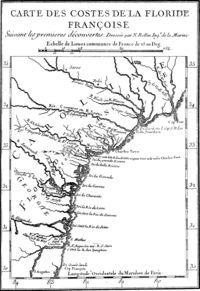| Action of September 1565 | |||||||
|---|---|---|---|---|---|---|---|
| Part of French colonial conflicts | |||||||
 Image of French settlement in Florida in 1562. | |||||||
| |||||||
| Belligerents | |||||||
|
|
| ||||||
| Commanders and leaders | |||||||
|
|
| ||||||
| Strength | |||||||
| 49 ships (including merchant ships) | 33 ships | ||||||
| Casualties and losses | |||||||
| 1 admiral, 700 men | |||||||
The Spanish assault on French Florida began as part of imperial Spain's geopolitical strategy of developing colonies in the New World to protect its claimed territories against incursions by other European powers. From the early 16th century, the French had historic claims to some of the lands in the New World that the Spanish called La Florida. The French crown and the Huguenots led by Admiral Gaspard de Coligny believed that planting French settlers in Florida would help defuse religious conflicts in France and strengthen its own claim to a part of North America.[1][2] The Crown wanted to discover and exploit valuable commodities,[3][4] especially silver and gold, as the Spanish had done[5] with the mines of Mexico and Central and South America. The political and religious enmities that existed between the Catholics and Huguenots[6] of France resulted in the attempt by Jean Ribault in February 1562 to settle a colony at Charlesfort on Port Royal Sound,[7] and the subsequent arrival of René Goulaine de Laudonnière at Fort Caroline, on the St. Johns River in June 1564.[8][9][10]
The Spanish laid claim to a vast area that included the modern state of Florida, along with much of what is now the southeastern United States, on the strength of several expeditions in the first half of the 1500s, including those of Ponce de Leon and Hernando de Soto. However, Spanish attempts to establish a lasting presence in La Florida failed until September 1565, when Pedro Menéndez de Avilés founded St. Augustine about 30 miles south of Fort Caroline. Menendez had not known that the French had already arrived in the area, and upon discovering the existence of Fort Caroline, he aggressively moved to expel those whom he considered heretics and intruders. When Jean Ribault learned of the Spanish presence nearby, he also decided on a swift assault and sailed south from Fort Caroline with most of his troops to search for St. Augustine. However, his ships were struck by a storm (possibly a tropical storm) and most of the French force was lost at sea, leaving Ribault and several hundred survivors shipwrecked with limited food and supplies near Mosquito Inlet (Ponce de Leon Inlet), about 60 miles south of the Spanish colony. Meanwhile, Menendez marched north, overwhelmed the remaining defenders of Fort Caroline, massacred most of the French Protestants in the town, and left an occupying force in the rechristened Fort Mateo. Upon returning to St. Augustine, he received news that Ribault and his troops were stranded to the south. Menendez quickly moved to attack and massacred the French force on the shore of what became known as the Matanzas River, sparing only the Catholics among the French.[citation needed]
With Fort Caroline captured and the French forces killed or driven away, Spain's claim to La Florida was legitimized by the doctrine of uti possidetis de facto, or "effective occupation",[11] and Spanish Florida stretched from the Panuco River on the Gulf of Mexico up the Atlantic coast to Chesapeake Bay,[12] leaving England and France to establish their own colonies elsewhere. While Spain's rivals did not seriously challenge its claim to the vast territory for decades, a French force attacked and destroyed Fort Mateo in 1568, and English pirates and privateers regularly raided St. Augustine over the next century.[13]
- ^ Gerhard Spieler (2008). Beaufort, South Carolina: Pages from the Past. The History Press. p. 14. ISBN 978-1-59629-428-8.
- ^ Alan James (2004). The Navy and Government in Early Modern France, 1572-1661. Boydell & Brewer. p. 13. ISBN 978-0-86193-270-2.
- ^ Elizabeth J. Jean Reitz; C. Margaret Scarry (1985). Reconstructing Historic Subsistence with an Example from Sixteenth Century Spanish Florida. Society for Historical Archaeology. p. 28.
- ^ Scott Weidensaul (2012). The First Frontier: The Forgotten History of Struggle, Savagery, and Endurance in Early America. Houghton Mifflin Harcourt. p. 84. ISBN 978-0-15-101515-3.
- ^ John T. McGrath (2000). The French in Early Florida: In the Eye of the Hurricane. University Press of Florida. p. 63. ISBN 978-0-8130-1784-6.
- ^ Dana Leibsohn; Jeanette Favrot Peterson (2012). Seeing Across Cultures in the Early Modern World. Ashgate Publishing, Ltd. p. 205. ISBN 978-1-4094-1189-5.
- ^ Charles E. Bennett (1964). Laudonnière & Fort Caroline: History and Documents. University of Florida Press. p. 15. ISBN 9780598211859.
- ^ Cameron B. Wesson; Mark A. Rees (23 October 2002). Between Contacts and Colonies: Archaeological Perspectives on the Protohistoric Southeast. University of Alabama Press. p. 40. ISBN 978-0-8173-1167-4.
- ^ Stephen Greenblatt (1 January 1993). New World Encounters. University of California Press. p. 127. ISBN 978-0-520-08021-8.
- ^ Connaissances et pouvoirs: les espaces impériaux (XVIe-XVIIIe siècles) : France, Espagne, Portugal. Presses Université de Bordeaux. 2005. pp. 41–46. ISBN 978-2-86781-355-9.
- ^ Lyle N. McAlister (1984). Spain and Portugal in the New World, 1492-1700. U of Minnesota Press. p. 306. ISBN 978-0-8166-1216-1.
- ^ Donald William Meinig (1986). The Shaping of America: Atlantic America, 1492-1800. Yale University Press. p. 27. ISBN 978-0-300-03882-8.
- ^ Margaret F. Pickett; Dwayne W. Pickett (8 February 2011). The European Struggle to Settle North America: Colonizing Attempts by England, France and Spain, 1521-1608. McFarland. p. 81. ISBN 978-0-7864-6221-6.
